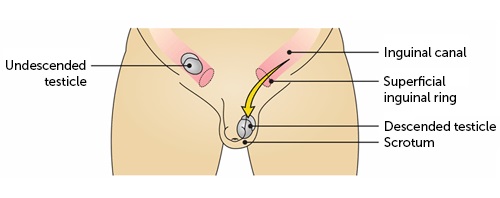
Undescended testis
An undescended testicle (cryptorchidism) is a testicle that hasn't moved into its proper position in the bag of skin hanging below the penis (scrotum) before birth. Typically, only one testicle is affected, but approximately 10% of the time both testicles are undescended. During fetal development, the testicles form in the abdomen. During the last few months of normal fetal development, the testicles gradually descend from the abdomen into the scrotum via a tube-like passageway in the groin (inguinal canal). That process is stopped or delayed in the presence of an undescended testicle.
Symptoms
Most babies and children with this condition have no symptoms. The only sign is that the scrotum is empty. The main sign of an undescended testicle is not seeing or feeling a testicle where you would expect it to be in the scrotum.
Tests and Treatment
During a physical exam, the doctor can usually feel or palpate the undescended testicles. However, in some boys, the undescended testicles may not be in a detectable location. If an undescended testicle is not easily felt or palpable, a pelvic ultrasound can be used to pinpoint its exact location.
Undescended testicle treatment options include:
- Hormone therapy: In rare cases — especially when the testicles are near the scrotum — your healthcare provider may recommend hormonal treatment. The child is given a series of hCG (human chorionic gonadotropin) injections. Hormones cause the testicles to fall into the scrotum.
- Surgery: The most common and effective treatment for undescended testicles is surgery. Orchiopexy refers to the procedure of moving the testicles into the scrotum. It is usually best if your child has surgery between the ages of six months and one year.
Make an appointment right away for consultation on your urological issue.
Call With Doctor